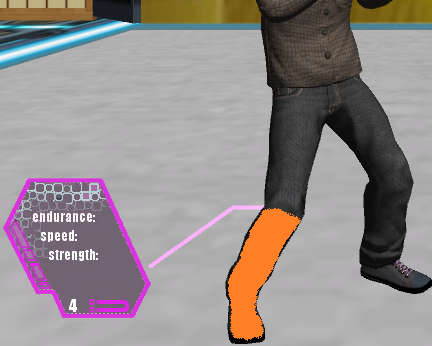I want to achieve the following effect in a Unity game: I have a 3D model and, under certain conditions, I want to change the color of one of its limbs only, let's say right leg (see screenshot below, with an example of how I want it to look). This is intended to highlight the limb in question.
I've been doing a lot of research and using custom shaders comes up often, but in all of the examples I've seen they only show how to draw an outline around the 3D model, which is not what I want. The only other suggestions I've found are to either use projectors (for drawing effects on mesh surfaces in real time) or to change the vertex colors programatically during run-time. Both of those suggestions are from the following question: https://stackoverflow.com/questions/34460587/unity-changing-only-certain-part-of-3d-models-color. The latter suggestion is the closest to what I want to achieve, but it doesn't seem to be working for me. Here is the C# code for accomplishing the change in vertex colors:
using UnityEngine;
using System.Collections;
public class BoneHiglighter : MonoBehaviour {
public Color32 highlightColor = Color.red;
public Color32 regularColor = Color.white;
public SkinnedMeshRenderer smr;
// Just for sake of demonstration
public Transform bone;
private Transform prevBone;
// Find bone index given bone transform
int GetBoneIndex(Transform bone) {
Debug.Assert(smr != null);
var bones = smr.bones;
for (int i = 0; i < bones.Length; ++i) {
if (bones[i] == bone) return i;
}
return -1;
}
// Change vertex colors highlighting given bone
void Highlight(Transform bone) {
Debug.Assert(smr != null);
var idx = GetBoneIndex(bone);
var mesh = smr.sharedMesh;
var weights = mesh.boneWeights;
var colors = new Color32[weights.Length];
for (int i = 0; i < colors.Length; ++i) {
float sum = 0;
if (weights[i].boneIndex0 == idx && weights[i].weight0 > 0)
sum += weights[i].weight0;
if (weights[i].boneIndex1 == idx && weights[i].weight1 > 0)
sum += weights[i].weight1;
if (weights[i].boneIndex2 == idx && weights[i].weight2 > 0)
sum += weights[i].weight2;
if (weights[i].boneIndex3 == idx && weights[i].weight3 > 0)
sum += weights[i].weight3;
colors[i] = Color32.Lerp(regularColor, highlightColor, sum);
}
mesh.colors32 = colors;
}
void Start() {
// If not explicitly specified SkinnedMeshRenderer try to find one
if (smr == null) smr = GetComponent<SkinnedMeshRenderer>();
// SkinnedMeshRenderer has only shared mesh. We should not modify it.
// So we make a copy on startup, and work with it.
smr.sharedMesh = (Mesh)Instantiate(smr.sharedMesh);
Highlight(bone);
}
void Update() {
if (prevBone != bone) {
// User selected different bone
prevBone = bone;
Highlight(bone);
}
}
}What is the best way to achieve the effect I want in Unity?







